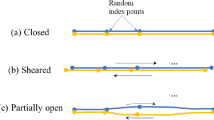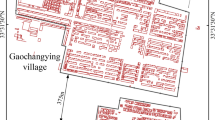Abstract
The fractured zones caused by mining were studied in the overburden of the Torezko-Snezhnyanskaya area, Ukraine, through the change in natural gas emission from these zones during longwall coal excavation. Zones of interconnected fractures and separate horizontal fractures were studied with vertical wells drilled from the ground surface down to active underground workings. The maximum heights of the zone of interconnected fractures and separate horizontal fractures may reach 19–41 and 53–92 times the thickness of the coal seam respectively. It was found that the ratio between the maximum height of the zone of interconnected fractures and the thickness of the extracted coal seam increases with the increasing number of rock layer interfaces and decreases with the increasing stiffness of immediate roof. It is shown that the growth of the zone of interconnected fractures occurred during 17–39 days at an average rate of 0.94–1.97 m day−1 and it was accompanied by increasing methane emission from overburden. Observation shows that the formation of separate horizontal fractures began only 11–49.5 days after the height of the zone of interconnected fractures reached its maximum value. Formation of separate horizontal fractures in overburden over the longwall excavation occurred as a stepped process from lower to upper sandstone–sandy shale layer interfaces in the direction of the ground surface.













Similar content being viewed by others
References
Ayruni A, Iofis M, Palchik V (1985) New approach to the evaluation of gas well effectiveness. Coal 11:54–55
Bai M, Elsworth D (1990) Some aspects of mining under aquifers in China. Mining Sci Technol 10(1):81–91
Burrel R, Friel S (1996) The effect of mine closure on surface emission. In: Proc Conf Environmental Management of Mine Operations. IBS, London
Chekan G, Listak J (1993) Design practices for multiple-seam longwall mines. US Bureau of Mines, Pittsburgh, PA, Inf Circ 9360
Hasenfus GJ, Johnson KL, Su DWH (1988) A hydrogeomechanical study of overburden aquifer response to longwall mining. In: Proc 7th Conf Ground Control in Mining, 3–5 August 1988, Morgantown. West Virginia University, Morgantown, pp 144–152
Iofis M, Palchik V (1984) Correlation between deformation and gas emission from rock mass. USSR Academy of Sciences, Moscow, pp 35–44
Karmis M, Triplett T, Haycocks C, Goodman G (1983) Mining subsidence and its prediction in an Appalachian coalfield. In: Rock mechanics: theory, experiment, practice. Proc 24th US Symp Rock Mechanics, 20–23 June 1983, Texas A&M University. Balkema, Rotterdam, pp 665–675
Kendorski FS (1993) Effect of high-extraction coal mining on surface and ground waters. In: Proc 12th Conf Ground Control in Mining, Morgantown. West Virginia University, Morgantown
Kral V, Paletnik M, Novotny R (1998) Methane from closed-down mines in the soil. In: Proc Int Conf Coal-Bed Methane Technologies of Recovery and Utilization. GIG, Katowice, Poland
Kratzsch H (1983) Mining subsidence engineering. Springer, Berlin Heidelberg. New York
Palchik V (1985) Gas dynamics of undermined rock mass. Physical and technical problems of mineral resource extraction. USSR Academy of Sciences, Moscow, pp 83–86
Palchik V (1989) Analytical and empirical prognosis of rock foliation in rock masses. J Coal Ukraine 7:45–46
Palchik V (2002a) Influence of physical characteristics of weak rock mass on height of caved zone over abandoned subsurface coal mines. Environ Geol 42(1):92–101
Palchik V (2002b) Use of Gaussian distribution for estimation of gob gas drainage well productivity. Math Geol 34(6):743–765
Peng SS (1992) Surface subsidence engineering. Society for Mining, Metallurgy and Exploration
Sizer K, Creedy D, Sceal J (1996) Methane and other gases from disused coal mines: the planning response. Technical report for Department of the Environment. Wardell Armstrong, The Stationery Office, London
Turchaninov IA, Iofis MA, Kasparian EV (1977) Principles of rock mechanics. Nedra, Leningrad
Whittaker BN, Reddish DJ (1989) Subsidence: occurrence, prediction and control. Elsevier, Barking
Acknowledgements
I thank the anonymous reviewers for their very helpful remarks and suggestions, and Mrs. L. Tomson for her English review.
Author information
Authors and Affiliations
Corresponding author
Rights and permissions
About this article
Cite this article
Palchik, V. Formation of fractured zones in overburden due to longwall mining. Env Geol 44, 28–38 (2003). https://doi.org/10.1007/s00254-002-0732-7
Received:
Accepted:
Published:
Issue Date:
DOI: https://doi.org/10.1007/s00254-002-0732-7




